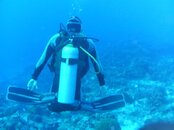- Messages
- 22,171
- Reaction score
- 2,803
- # of dives
- 5000 - ∞
Peter has it right. Horizontal hover, face up, face down, vertical over, head up, head down, and everything in between. Even Buddha for the fun of it, head up and head down.
Welcome to ScubaBoard, the world's largest scuba diving community. Registration is not required to read the forums, but we encourage you to join. Joining has its benefits and enables you to participate in the discussions.
Benefits of registering include
Most every time I have seen the Buddha position, it's been a case of "Look at me! Aren't I cool?" When that diver comes out of the Buddha pose only six inches above the reef, what happens to their feet? I am anything but a horizontal nazi. Anyone who dives with me can attest to seeing me upside down, sideways, flat to the bottom (without touching) and more. All the time I am consistently worried about what my feet are doing so I don't kick the reef. NASE really sets itself apart from the other agencies by not setting bad examples for students during the OW dives. One descent/one ascent per dive, doing all skills neutrally and off the bottom, working on gas management and buddy skills from the beginning go a long way to teaching how to dive while the instructor walks the walk as well. It's not that NASE doesn't teach a CESA... we do it horizontally in a pool, where we set a great example by not exposing the instructor to bubble pumping and not giving the students the idea that bounce dives are acceptable. In fact, the student has to show exemplary skills in the pool or it's no OW dives until they do. It's sad that an agency striving for excellence in these areas is labeled by Thal as being "insulting".BTW, Netdoc, your comment about not wanting to do a Budha Hover while looking under something is just one of those comments that perhaps shows you don't understand that everyone should be able to maintain many different "hovers." It is just as bad as being a cave diver and saying you should always be horizontal -- Hmmm, try going UP a small chimney while horizontal when, in reality, you may well want to be (or need to be) vertical. The key is being neutral and controlling your position -- not the position itself, is it not?
That's not a GOOD Buddha.

Most every time I have seen the Buddha position, it's been a case of "Look at me! Aren't I cool?"
NASE feels it's instructors have done a fine job of representing them in this thread. In fact, Scott Evans and I discussed this very thread for some length and he brought out an interesting point. Most agencies have neutral buoyancy as a skill to be demonstrated for a discreet amount of time. NASE requires neutral buoyancy to be demonstrated THROUGHOUT the open water dives: the entire dive.Interesting. In 8 pages of discussion NASE has not replied at all, interested in the NASE view of all these posts.
